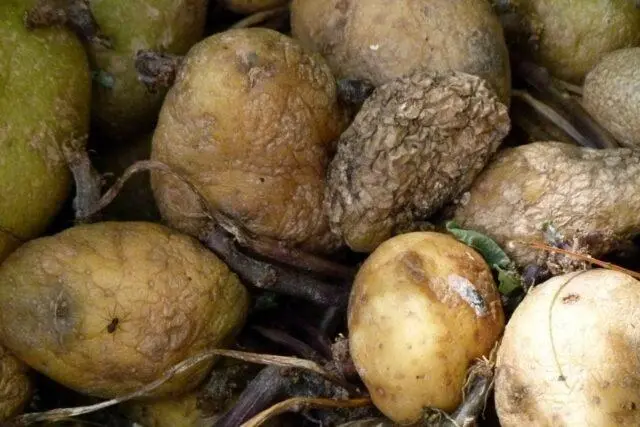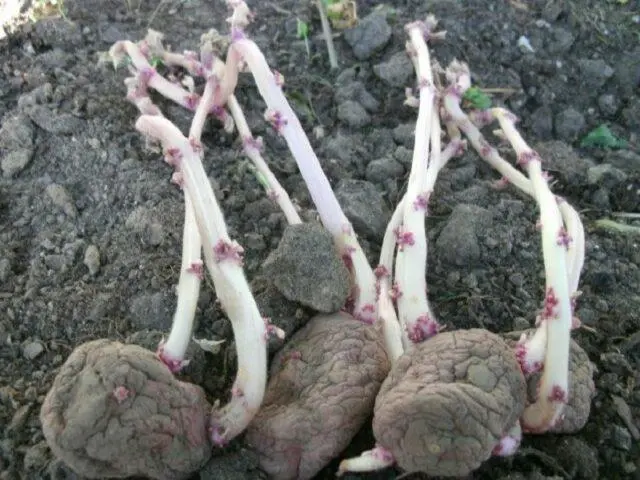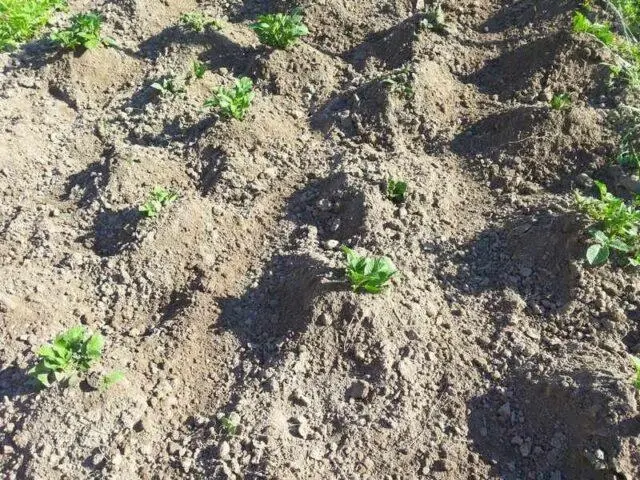Contents
If the potatoes are frozen during storage, this is not at all a reason to get rid of the crop, because gardeners have long learned to use such root crops not only for consumption, but also for planting. According to the experience of vegetable growers, even if you plant frozen potatoes, you can get a good harvest. Naturally, this is possible only if certain rules are observed.

If the frozen potato has sprouted, then it is suitable for planting.
Why do potatoes freeze
There are several reasons for freezing potatoes. This may be due to untimely harvesting or improper storage. Experienced gardeners rarely make such a mistake as being late in harvesting root crops, so storage errors are still considered the main causes of freezing, these include:
- non-compliance with the temperature regime, since even an indicator of 0 ºC can cause partial freezing of tubers;
- high air humidity, from 85%;
- the storage room is not well ventilated or not ventilated.
Fortunately, the freezing of potatoes is not always the reason for getting rid of the crop. You can try to save root crops for their further use. After all, slightly frozen potatoes can be planted and even eaten.
What to do if the potatoes are frozen
If it was noticed that the temperature regime was violated or for some other reason the potatoes were frozen, you should not immediately panic. It is important to respond to this situation in a timely manner and take the necessary measures in time. To do this, the tubers are transferred to the room, but the temperature should not be too high, +6 ºC is enough. If you immediately move the crop to a warm place (above +10 ºC), then a heavily frozen potato will become soft and slippery, which may cause rotting of neighboring root crops.
How to save a frozen potato
You can save a frozen potato after moving it from a cold room. First, the crop is carefully inspected, removing spoiled and severely frozen root crops, then the tubers are sorted, wiped and laid out in 1-2 layers to dry. Leave the potatoes for a few days, then look again, so as not to miss badly spoiled specimens.
Those root crops that can be reanimated are suitable for consumption, but they will have a sweet unpleasant aftertaste, so gardeners try to use frozen potatoes for planting.
Is it possible to plant frozen potatoes
Potatoes that have been slightly frozen can be used for planting. And do not think that such material does not give a good harvest. As a rule, in slightly frozen root crops, the main part remains viable, which, under favorable conditions, can give rise to shoots. At the same time, it is important to properly process the tubers so that the process of decay does not begin.

Even frozen potatoes can produce healthy, viable sprouts.
Of course, it is best to plant frozen potatoes with sprouts so that they germinate, since without shoots such planting material can only give 50-60% germination.
If the tubers are without shoots, then they should be germinated before planting; for this, the roots are moved to a warm room. And if sprouts began to appear in the majority, then it is they who are suitable for planting, while the rest are rejected and thrown away.
When the first shoots were seen, the planting material is disinfected by spraying with a slightly pink solution of manganese. This allows you to moisten the tubers for swelling of the sprouts, and will also prevent rotting.
When the sprouts are about 2-3 cm and look swollen and strong enough, then you can plant such frozen potatoes.
Germination of frozen potatoes can be done in several ways. The first involves moving frozen root crops from a cold room to a greenhouse in May. They are laid out in one layer and left until the first sprouts appear. No additional manipulations, except for spraying and removing damaged tubers, are required.
In the second version, in spring, when the temperature is within +12-15 ºC, in order to plant frozen potatoes, they are first taken out into the street in wooden boxes. When in the sun, sprouts will begin to appear faster, such shoots will be stronger. The survival rate of planting material in this case will be much higher.
There are no special rules for planting frozen planting material; it is enough to properly prepare root crops. The planting scheme can be used as standard – the distance between the bushes in a row is about 40 cm, and the row spacing is at least 50 cm. The depth of the tubers should be maintained at about 15 cm. And the soil should also be moistened at the time of planting. The rest depends on the quality of care for garden crops.
Care after landing
Unlike planting quality root crops, planting frozen potatoes is using unhealthy planting material. Therefore, subsequent care should be especially careful. It consists not only in monitoring seedlings, but also in performing a number of other agrotechnical processes.
A week after planting frozen potatoes, the soil should be loosened. It is best to do this with a rake. This tool well splits the hardened crust of the soil and at the same time does not penetrate deeply, which will prevent damage to seedlings.
Watering is carried out only if there is no rain for a long time. In this case, after irrigating the soil, the loosening procedure must be repeated. At this point, weeds should also be removed so that they do not drown out the emergence of seedlings.
Hilling is a mandatory procedure, especially if you had to plant frozen potatoes. This will eliminate the re-influence of cold temperatures on planting material. Hilling is carried out for the first time as soon as potato seedlings “hatch”. To do this, a small mound is formed above them.

With proper hilling, after 2-3 days, the shoots will come out again
The second time spud after two weeks. This is necessary for the formation of root crops, since the mound of earth protects the tubers from sunlight, as well as from overheating.
Conclusion
You can plant frozen potatoes, the main thing is to correctly select the planting material. Completely frozen specimens, which after thawing become soft and slimy, as well as root crops with signs of decay, are subject to removal. Viable balls will be suitable for planting, while the yield will be no worse.










